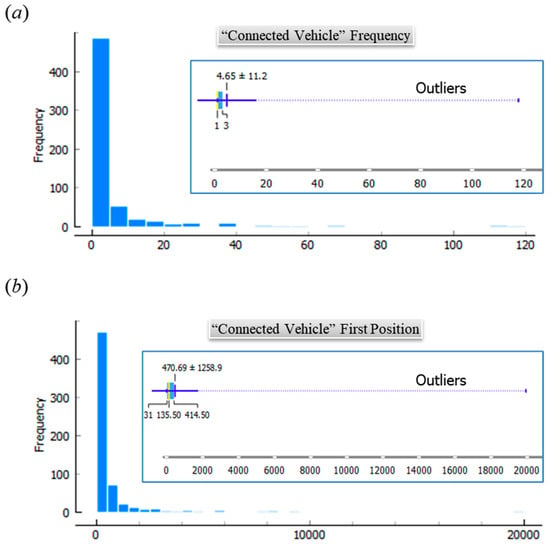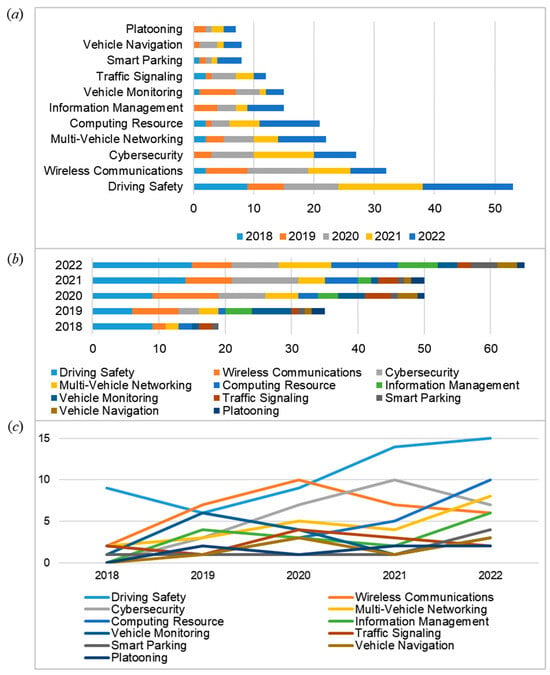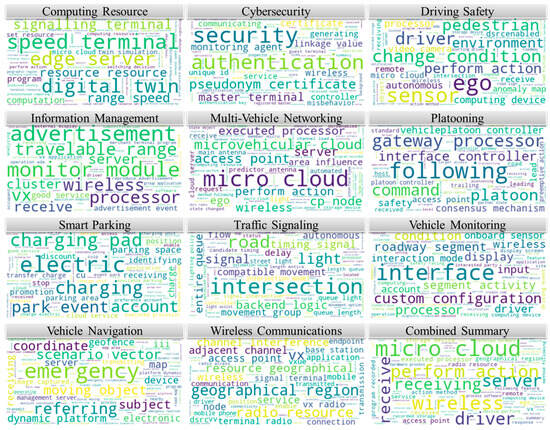You're using an outdated browser. Please upgrade to a modern browser for the best experience.
Please note this is a comparison between Version 1 by Raj Bridgelall and Version 2 by Lindsay Dong.
Governments and manufacturers anticipate that connected vehicle deployments will reduce accidents, optimize traffic flow, and enhance the driving experience. Although extensive studies focus on the technical aspects of connected vehicles, a gap exists in systematically analyzing the invention trends shaping the field. Insights into these trends is a strategic imperative for policymakers, researchers, and investors alike.
- cybersecurity
- driving safety
- wireless communications
1. Introduction
Connected vehicle (CV) technology promises revolutionary enhancements in driving safety, efficiency, and convenience. CVs have the potential to reduce accidents, optimize traffic flow, and enhance the driving experience by communicating with each other (V2V) and with everything else (V2X) [1]. In 2020, the U.S. Federal Communications Commission (FCC) repurposed 60% of the spectrum in a safety band dedicated to vehicle use, causing uncertainty and stalled investments [2]. Therefore, understanding this landscape will guide future research, policymaking, and investment decisions.
Connected vehicle technology is interdisciplinary, encompassing theories of transportation, computing, and engineering. Researchers have deeply explored the landscape of connected vehicles to understand the architectures, enabling technologies, applications, and development areas. Siegel et al. (2017) provided a comprehensive survey that summarized the state of the art in connected vehicles, discussing the challenges and opportunities in terms of privacy, security, scalability, and extensibility [3]. Yang et al. (2018) delved into the status and future perspectives of CVs, focusing on key technologies needed for their future deployment [4]. Ahmed et al. (2022) assessed the technological developments and impacts of connected and autonomous vehicles (CAVs), including government guidance, legislation, and regulations affecting their applications [5]. These works lay the groundwork for specialized studies in various aspects of connected vehicles, as described in the next subsections.

1.1. Networking
Amadeo et al. (2016) advocated a paradigm shift from traditional IP-based networking to information-centric networking to meet the challenges of maintaining wireless communications link speed, quality, and reliability in vehicular networks [6]. Soto (2023) examined road safety and traffic efficiency applications based on cellular-V2X technologies, emphasizing the role of digital communication in enhancing vehicular operations. Arthurs et al. (2021) examined edge cloud computing that enables vehicles to connect existing sensors such as road cameras, traffic density sensors, traffic speed sensors, emergency vehicle transmissions, and public transport transponders [7]. Nkenyereye et al. (2023) explored the fusion of fifth-generation (5G) cellular networks to enable software-defined vehicular cloud computing, an emerging technology where clusters of vehicles can share resources, sensor data, and complete tasks in a mobile ad hoc cloud environment [8].1.2. Security and Cybersecurity
Security remains a crucial concern in the connected vehicle ecosystem. Shichun et al. (2023) provided a detailed review of cybersecurity techniques for CVs, discussing threat analysis, risk assessment, and intrusion detection [9]. Rathore et al. (2023) scrutinized challenges in in-vehicle communication cybersecurity [10]. Ju et al. (2022) surveyed attack detection and resilience from a vehicle dynamics and control perspective [11]. Hildebrand et al. (2023) presented a comprehensive review of the integration of blockchain technology in-vehicle networking to add trustworthiness and immutability [12]. Khan et al. (2023) proposed a secure communication system for CAVs using blockchain technology, focusing on privacy and protection against cyber threats like distributed denial of service attacks [13].1.3. Traffic Management
Alanazi (2023) performed an SLR focusing on how autonomous vehicles manage traffic at junctions, categorizing approaches into rule-based, optimization, hybrid, and machine-learning procedures [14]. Shi et al. (2023) devised a real-time control algorithm for CAVs in signalized corridors, aiming to minimize fuel consumption and avoid idling [15]. Gholamhosseinian and Seitz (2022) completed a comprehensive survey on cooperative intersection management for CVs [16]. Xu et al. (2023) proposed an origin-destination-based partition technique to improve arterial signal coordination using data from CVs [17]. Zhu et al. (2022) conducted a comprehensive review of merging control strategies at freeway on-ramps [18]. Wang et al. (2022) discussed the development of CV cooperative driving systems, focusing on vehicle collaborative control algorithms and communication optimization [19].1.4. Road Safety
Cui et al. (2022) reviewed cooperative perception technologies that aimed to fuse local and edge-sensing data to improve situational awareness and eliminate blind spots [20]. Khanal et al. (2023) used CV data to develop crash prediction models for intersections and road segments, offering a proactive approach to road safety [21]. Gao et al. (2023) provided a review and outlook on predictive cruise control of vehicles under cloud control systems, emphasizing the role of predictive algorithms in enhancing traffic efficiency and safety [22]. Islam and Abdel-Aty (2023) used CV data to predict traffic conflicts [23]. Schwarz et al. (2022) examined the role of digital twin simulations in traffic management centers, digital maps, onboard diagnostics, and route planning [24]. Overall, the existing literature spans assorted topics from foundational understanding, networking paradigms, and security concerns to traffic management algorithms, safety measures, and emerging technologies. While the industry has made considerable progress, challenges in security, real-time control, and traffic management persist, requiring future research to realize the full potential of CVs.2. Patent of Connected Vehicle Technology Trends
The USPTO database holds a total of 1,637,725 patents across the five-year period, which amounted to an annual average of 327,545 patents. The SPR workflow identified 220 relevant patents from that period. These data revealed that the USPTO awarded an average of 44 patents annually that focused on connected vehicles, a 50% increase from 2018 to 2022. Term frequency-based relevance filtering reduced the number of patents that focused on connected vehicles by an average of 58.5%, yielding 254 patents in total. Further filtering to eliminate term position outliers further reduced the number of relevant patents to 224. Figure 12a shows the distribution of the term frequency and Figure 12b shows the distribution of the first position of mention for the term. Each figure’s inset displays a box plot of the distribution statistics. Specifically, the term “connected vehicle” appeared on average 4.65 times with a standard deviation of 11.2. The first quartile ended with a frequency of 1, and the third quartile began with a frequency of 3. SME analysis identified four patents that were not relevant because of term confusion. The confused patents discussed methods to physically “connect” a vehicle to an object or another vehicle in tow.
Figure 12.
Distribution of (
a
) key phrase frequency and (
b
) first position of occurrence.
Table 13 categorizes the SME classification of patent objectives and describes the general focus and methodologies employed within each category. Figure 23 shows the distribution of each objective class by frequency, year, and temporal trend per class. Patents concerning CVs have risen steadily since 2018. The dominant objective of enhancing driving safety increased since 2019. Figure 34 shows individual word clouds for each of the objective categories. Dominant keywords within each word cloud, upon inspection, aligned well with the SME description of patent objectives for each category.


Figure 23.
Distribution of patent objectives by (
a
) classes, (
b
) by year, and (
c
) temporal class trend.


Figure 34.
Word cloud for each objective category.
Table 13.
SME Classification of General Patent Objectives.
| Objective | General Description |
|---|---|
| Computing Resource |
Communications traffic to exchange sensor data and a wide range of other information, including the need for low latency to meet real-time demands place additional burdens on available computational resources. Objectives target optimal resource allocation and usage of onboard and cloud-based computing resources and optimizes communications across multiple network interfaces and servers. |
| Cybersecurity | Growing wireless connectivity between vehicles and other things, including other vehicles, expands the vulnerability surface for cyber-attacks. Objectives address enhanced cybersecurity including encryption, authentication, and intrusion detection methods. |
| Driving Safety |
Objectives utilize vehicle-to-everything connectivity and sensors on other vehicles to enhance visibility and situational awareness. Safely navigating in complex environments, including through intersections and among pedestrians, and avoiding collisions. |
| Information Management |
Demand for efficient management of information across software applications and services scales with increased vehicle connections. Objectives assure that systems present relevant information to vehicle operating and in-cabin infotainment systems to prevent data overload and prioritize information that is essential for vehicle operation, safety, and user experience. |
| Multi-vehicle Networking |
Vehicle clusters can form and maintain micro vehicular clouds to efficiently share and exchange information. Objectives address the efficient use of resources among vehicles to enable capabilities such as distributed data storage, collaborative computing, reliable communications, and service provisioning. |
| Platooning | The streamlined aerodynamics of vehicles following each other more closely than normal (platooning) results in better fuel efficiency and improved traffic flow. Objectives address various ways to utilize wireless, sensors, and real-time control mechanisms to enable safer and more cost-efficient platooning and alerting law-enforcement. |
| Smart Parking |
Locating parking spaces in crowded and complex environments can be challenging and contribute to congestion. Objectives facilitate cooperative parking space searches, including charging for the “ego” vehicle by using sensors and micro vehicular clouds or centralized services. |
| Traffic Signaling |
Suboptimal traffic signal timing can exacerbate congestion. Objectives leverage wireless communications and sensors among vehicles to assess conditions and predict arrival times while dynamically optimizing traffic signaling for overall traffic impact. |
| Vehicle Monitoring |
Objectives aim to enrich in-cabin experiences for passengers through display devices that provide various forms of information and entertainment. Methods of preventing motion sickness by monitoring and predicting ride quality. |
| Vehicle Navigation |
Objectives update electronic maps with real-time data from vehicles for more accurate navigation. Detecting environmental changes dynamically such as topography, emergency situations, and seasonal conditions like flooding or snow to inform alternative routes. |
| Wireless Communications |
Objectives address advancements in wireless communications such as lower latency cellular networks, quality of service, resilience in noisy environments, and interference. |
Computing resource: dominant keywords include “speed”, “terminal”, “edge server”, and “digital twin”. These pertain to methods of offloading computing burden to edge servers and other terminals to increase the speed of information processing or employing digital twin simulations to inform the optimization of resources for enhanced reliability of information exchanges.
Cybersecurity: dominant keywords include “security”, “authentication”, and “pseudonym certificate”. These refer to enhancing the integrity of data exchanges through authentication and methods of reducing the computational burden of message signing by using pseudonym certificates to enhance privacy or detect malicious activities.
Driving safety: dominant keywords include “ego”, “driver”, “pedestrian”, “sensor”, “change condition”, and “environment”. These refer to methods of exchanging sensor data, using the focus or “ego” vehicle for orchestration, to improve situational awareness and visibility for both pedestrians and drivers and to detect changes in traffic or environmental conditions that inform driving adaptation.
Information management: dominant keywords include “advertisement”, “cluster”, “travelable range”, “monitor module”, “wireless”, and “processor”. These refer to using the wireless communications of vehicles within clusters such as at an event to broadcast relevant advertisements or to predict travel range through diverse processing and monitoring techniques.
Multi-vehicle networking: dominant keywords include “micro cloud”, “micro vehicular cloud”, “access point”, and “server”. These refer to means of collaboratively forming a virtual cloud computing facility by utilizing the computing resources and wireless communications of a vehicle group.
Platooning: dominant keywords include “following”, “gateway processor”, “interface controller”, and “platoon”. These refer to methods of controlling the “following” vehicle in a convoy to reduce air gaps by utilizing an interface controller and/or a gateway processor to synchronize vehicle movements.
Smart parking: dominant keywords include “electric”, “charging pad”, “park”, “event”, and “account”. These refer to utilizing the sensors of connected vehicles to share information about parking spot availability for example, at events, and to identify parking spots with vehicle-compatible electric chargers, including means to automatically bill an account.
Traffic signaling: dominant keywords include “intersection”, “road”, “light”, “signal”, and “timing”. These refer to adapting the signal timing of traffic lights based on sensing the queue length and traffic flow to increase intersection safety and throughput.
Vehicle monitoring: dominant keywords include “roadway segment”, “condition”, “onboard sensor”, “processor”, “interface”, and “custom configuration”. These refer to using sensors, processing, and computing interfaces to monitor the condition of vehicle and roadway segments for adaptive or custom configurations that will enhance the ride experience.
Vehicle navigation: dominant keywords include “emergency”, “coordinate”, “scenario vector”, “moving object”, “map”, and “geofence”. These refer to coordinating geospatial and map information among vehicles for situational analysis and route planning, including avoiding interference with emergency vehicles and slow-moving objects.
Wireless communications: dominant keywords include “geographical region”, “geographical resource”, “radio resource”, “channel interference”, “adjacent channel”, “access point”, “VX”, and “base station”. These refer to designing V-to-X (VX) communications systems that incorporate access points and base stations to minimize wireless interference and to adapt operations for improved channel reliability based on radio resources available in different geographical regions. Key objectives of the V-to-X inventions included increasing the reliability and decreasing the latency of wireless communications, especially while moving. Methods achieving those objectives included dedicating access points to a mobile user, switching between cellular and short-range wireless channels, dynamically optimizing network control parameters, selecting networks dynamically to minimize usage cost and loading, packet priority tagging, splitting femtocells to support multiple in-vehicle operators, keeping track of noisy locations to predict when to pre-load streaming content, mapping pre-determined radio resource locations to optimize performance, and leveraging satellite radio to increase the broadcast area for messages.
The aggregate summary reveals dominant keywords such as “micro cloud”, “wireless”, “receiving”, “driver”, and “perform action”. This suggests that at the aggregate level, the dominant invention themes involve improving the reliability of wireless communications, forming vehicular micro clouds to exchange information, receiving messages, and taking action to improve driving safety. These observations are consistent with the
